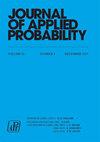关于两个合作企业的共同生存概率
IF 0.7
4区 数学
Q3 STATISTICS & PROBABILITY
引用次数: 1
摘要
我们考虑了控制两个企业捐赠过程的漂移和扩散率的问题,使得联合生存概率最大化。我们假设捐赠过程是由独立布朗运动驱动的连续扩散,并且集合捐赠是具有恒定漂移和扩散率的布朗运动。我们的结果表明,最大联合生存概率仅取决于总风险调整回报和每个企业可以实现的最大风险调整回报。这里,风险调整后的回报率被理解为漂移率除以扩散率的平方。本文章由计算机程序翻译,如有差异,请以英文原文为准。
On the joint survival probability of two collaborating firms
We consider the problem of controlling the drift and diffusion rate of the endowment processes of two firms such that the joint survival probability is maximized. We assume that the endowment processes are continuous diffusions, driven by independent Brownian motions, and that the aggregate endowment is a Brownian motion with constant drift and diffusion rate. Our results reveal that the maximal joint survival probability depends only on the aggregate risk-adjusted return and on the maximal risk-adjusted return that can be implemented in each firm. Here the risk-adjusted return is understood as the drift rate divided by the squared diffusion rate.
求助全文
通过发布文献求助,成功后即可免费获取论文全文。
去求助
来源期刊

Journal of Applied Probability
数学-统计学与概率论
CiteScore
1.50
自引率
10.00%
发文量
92
审稿时长
6-12 weeks
期刊介绍:
Journal of Applied Probability is the oldest journal devoted to the publication of research in the field of applied probability. It is an international journal published by the Applied Probability Trust, and it serves as a companion publication to the Advances in Applied Probability. Its wide audience includes leading researchers across the entire spectrum of applied probability, including biosciences applications, operations research, telecommunications, computer science, engineering, epidemiology, financial mathematics, the physical and social sciences, and any field where stochastic modeling is used.
A submission to Applied Probability represents a submission that may, at the Editor-in-Chief’s discretion, appear in either the Journal of Applied Probability or the Advances in Applied Probability. Typically, shorter papers appear in the Journal, with longer contributions appearing in the Advances.
 求助内容:
求助内容: 应助结果提醒方式:
应助结果提醒方式:


